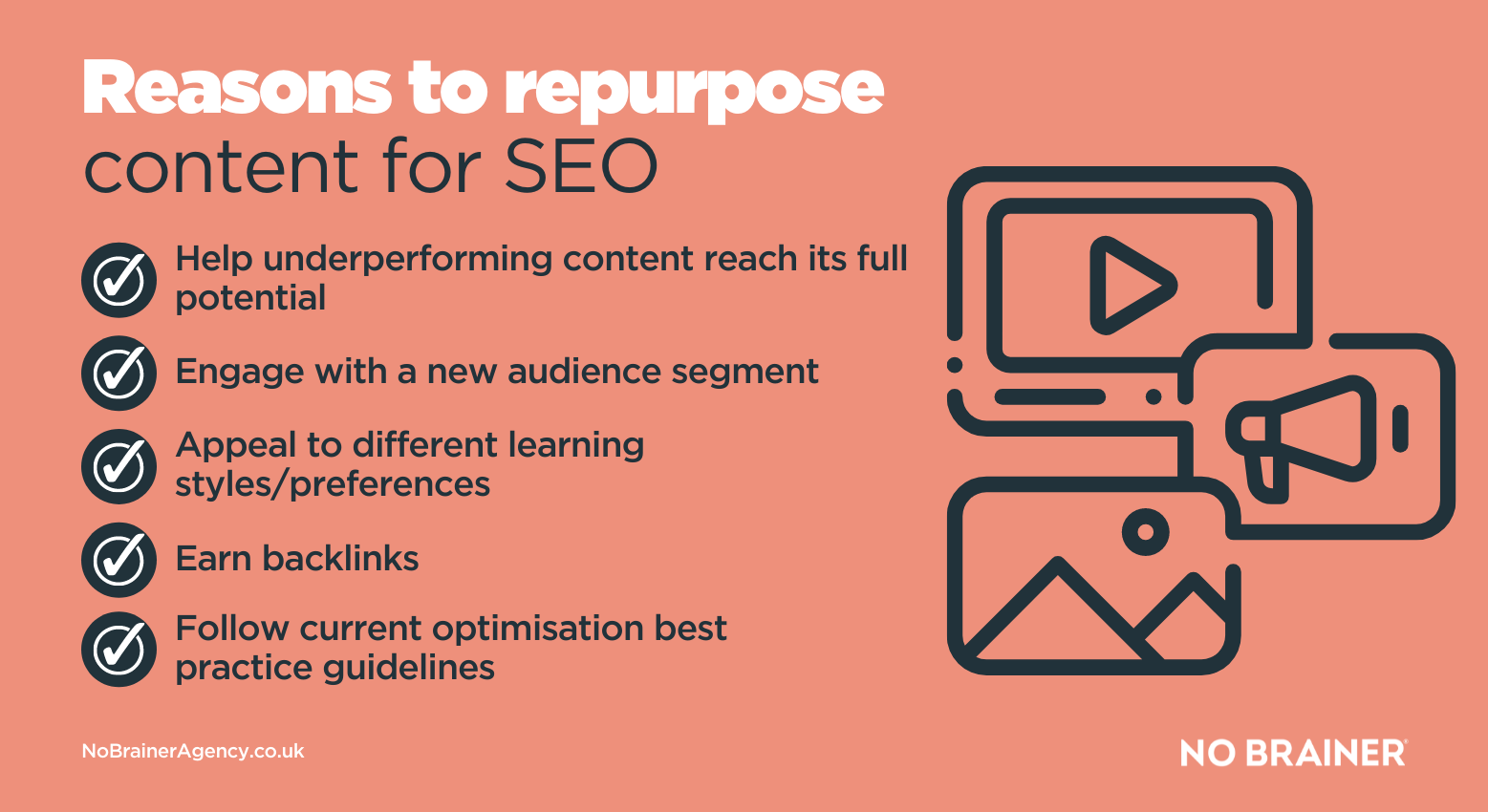Any content that you produce for your ecommerce brand’s online presence takes time, thought and often money, so it’s important that it provides the best possible return on that for the business. This can be easier said than done though, and many online retailers end up using their content in one way and then moving on to the next thing, which could mean they are missing out on potential revenue or potentially helping to nudge people along in their buyer journey towards making that all important purchase decision.
When it comes to SEO, search engines are all about the content! Content is what they serve up to users via the SERPs and there are multiple benefits to having content in different formats and types on ecommerce websites as well as being used within the wider marketing strategy, for both search engines and potential customers.
Why repurpose content?
Repurposing content isn’t simply taking a piece of content or a creative asset and using it on more than one marketing channel, it’s about changing that content in some way to turn it into something that is different from the original, and in a way that benefits the wider ecommerce SEO strategy.
Here’s 5 typical scenarios where brands should consider repurposing content:
1. Content that hasn’t reached its full potential
All marketers have probably experienced spending a significant amount of time and/or money on a piece of content that ends up not really achieving what we wanted it to, or reaching the potential we think it has. Repurposing can be a way to help make good content even better or giving it another chance to shine in a different context or with a new audience segment.
2. Content that needs optimisation
You could create the most beautiful and compelling piece of content, but if people can’t find it, then what’s the point? It might be that the original content hasn’t really taken SEO into consideration at all, so despite being really useful, it’s not going to appeal to search engines without some optimisation work being done on it to start driving organic visitors.
3. Content that has the potential for cross-appeal
Different people have different learning styles and engage best with different formats of content. For some people, a deep-dive blog post is their ideal way to take in information. For others, a video or other types of visual content are more suited to the ways in which they take things in. So, repurposing content into different formats can open your branded content up to different audiences than the original, and can be used on platforms best suited to that format, which perhaps the first piece wasn’t suited to. It’s important to get to know your audience as much as possible, to help inform the best medium to connect your content with them.
4. The best use of time and effort
Repurposing existing content is generally considerably quicker than starting a whole new content idea from scratch, which can make a big difference to the reward vs resource expended when creating content for an ecommerce brand.
5. Content that can generate backlinks
It’s a fact that people will link to content that means something to them, engages them or is especially useful, and backlinks are still a powerful ranking signal to search engines that a specific webpage is of value to searchers and should be shown near the top of SERPs for relevant search terms.
How do you know which content to repurpose for ecommerce SEO?
In order to get the best results, repurposing content needs to be done strategically, to make the best use of the time and resources available and weighing up the potential results/benefits for the business. While repurposing content will always have an element of risk involved (nothing is ever 100% guaranteed when it comes to SEO, after all), but you can take steps to stack the deck in your favour.
You can do this by making sure you adhere to SEO best practice and go for the opportunities that find a good balance between demand (i.e. keyword volume) and the competitiveness of the topic in the particular formats you’re considering.
In order for your new content piece to be successful, there needs to be some demand for it – and your repurposed piece needs to be better or more useful than whatever else is currently out there for those searching for this type of information. It also needs to have a role in moving potential customers along the funnel towards making a purchase, in order for there to be a real-world return for the business itself.
This quick sense check should help you decide if repurposing is a good way to go for a specific piece to bring additional benefit to the brand.
A quick look at your website’s existing content in your analytics tool, and perhaps Google Search Console, can help identify if particular pages are performing well or perhaps underperforming, but that’s not the only area you should look at.
Repurposing off-site content for SEO
It might be that content has been created for ecommerce marketing activity that didn’t actually take place on your brand’s website itself e.g. something that was used in social media or digital PR campaigns, for a podcast or webinar, or even offline activity. Repurposing this kind of content to benefit your website too can be a great way to being long-lasting benefits from the hard work that went into creating it originally.
This could include content such as:
- Turning press releases into text site content with visual elements e.g. graphs, tables and graphics for stats or other figures.
- Turning podcasts or webinars into short video recaps with an accompanying blog post
- Turning social media posts into video slides that can be embedded on your site, with accompanying text content
- Turning social media conversations/discussions or threads into blog posts
- Turning any stat-based off-site content into infographics with an accompanying blog post
Ways to repurpose site content for SEO
As well as utilising any of the above methods for content that is already on your site, you can also look to formats such as:
- Providing audio versions of some of your top-performing blog posts, especially if you know that a chunk of your audience like to listen to audio as a preferred content type to reading long-form pieces. This is also great for potential customers who may have a visual impairment, ensuring they can access your blog content too.
- Collating themed blog posts and other relevant content into an eBook (or whitepaper)
- Turning list-based blog content into videos or graphics, making sure you follow visual content best practice for SEO
- Turning positive customer reviews into optimised video content that can go onto product pages and act as a trust signal as well as being useful for social media too
Strategic repurposing of content on your ecommerce website can help ensure that a wider audience have the opportunity to engage with it, as well as ensuring that you’re giving pages on your website the best possible chance of ranking well in search engine results for relevant users. By making better use of content that already exists, this helps to ensure the business gets the best possible return on it, in the most cost-effective way.
If you would like any assistance with your ecommerce SEO or content strategy, our team would love to hear from you. Get in touch using the form below.








